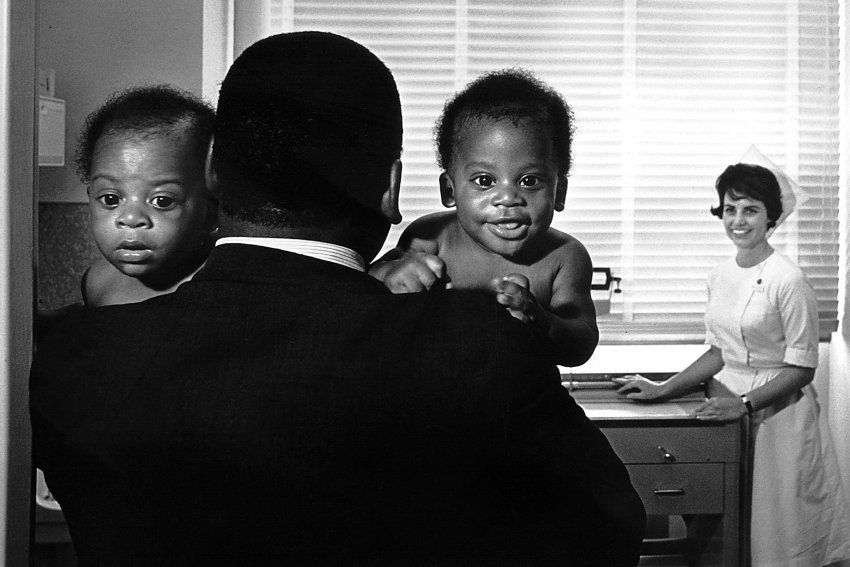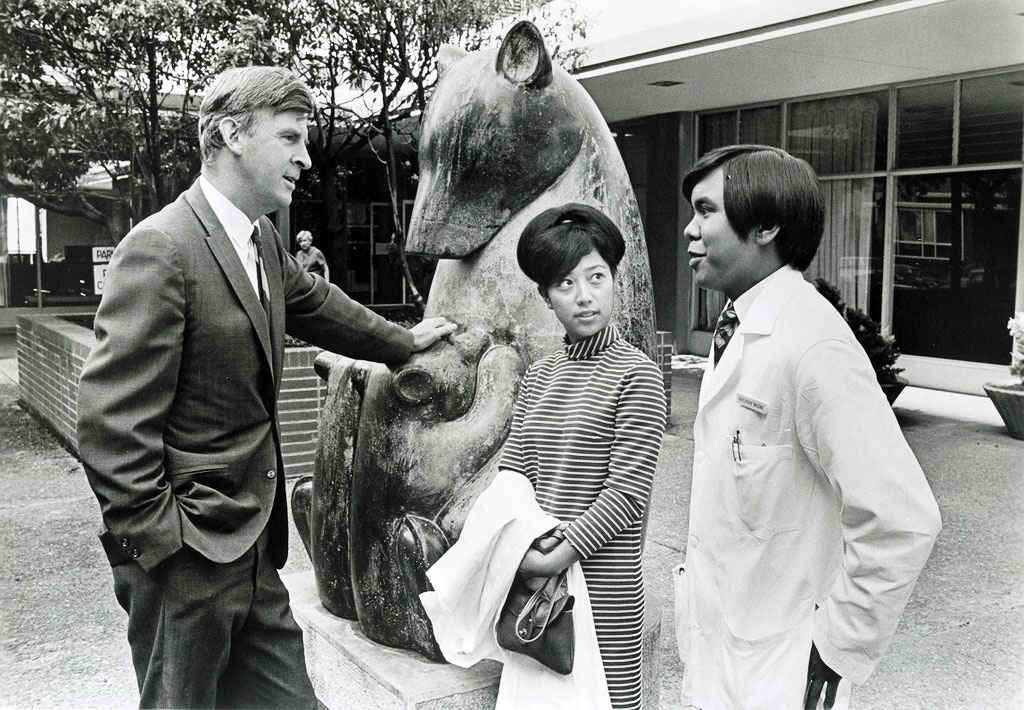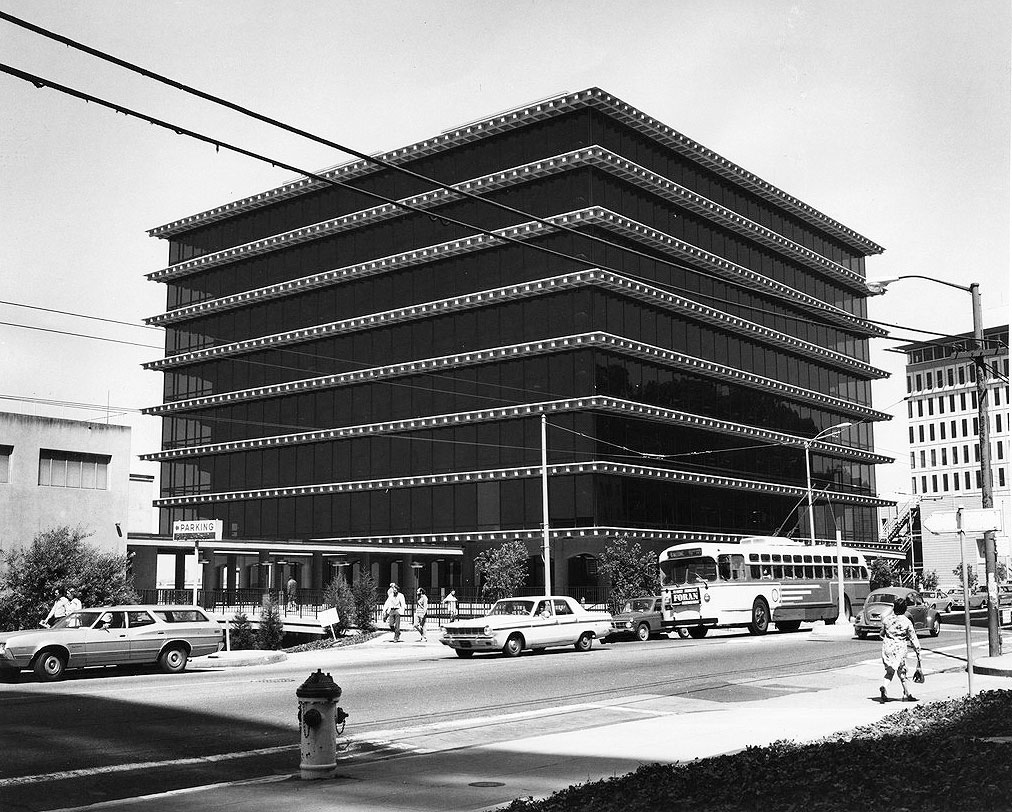History of UCSF, Part 2
Previous: 1860s-1950s

American photographer and San Francisco native Ansel Adams (1902-1984) visited UCSF during his long career, capturing this moment at UCSF Medical Center during the 1960s.
Gaining Autonomy
By the 1960s, the campus had shed its identity as “Cal’s Medical Center” and gained more autonomy as the entire UC system moved to decentralize. Each of the four schools by this time had been renamed “school of” in alignment with other UC campuses, and in 1961 the Graduate Division was established.
In 1964, the institution, operating under the name University of California, San Francisco Medical Center, was given full administrative independence, becoming the ninth campus in the UC system and the only one devoted exclusively to the health sciences. Provost John B. de C.M. Saunders, MD, was named the first chancellor.
Although popular with clinicians, Saunders was not as well received by researchers. He believed that training students and healing patients were paramount duties of the campus, with research ranking third. Faculty concerns led the UC Regents to ask him to step down, and in 1966 he resigned the post and took on a faculty appointment. That year, the Health Sciences East and Health Sciences West towers opened, which gave another boost to the research enterprise.
The same year, Willard C. Fleming, DDS, became the second chancellor and one of a few dentists to head a health sciences center. He was specifically chosen from outside the medical school to avoid further conflict between clinicians and researchers, and he provided the needed stabilization. The campus was on the road to becoming a full-fledged research university.
The medical school also had expanded its programs by entering into an affiliation agreement in 1968 to manage patient care, teaching and research at the San Francisco Veterans Administration (now Veterans Affairs) Medical Center (VAMC). Within 10 years, the San Francisco VAMC became a model of research and patient care for VA medical centers nationwide, a recognition that remains today.
Philip R. Lee, MD, became UCSF’s third chancellor in 1969, coming to UCSF from an assistant secretary post in the U.S. Department of Health, Education and Welfare. He led the campus during a time of political and social turmoil over civil rights and the Vietnam War.

UCSF's third chancellor, Philip R. Lee, brought a reformer's perspective to his tenure, working to increase minority recruitment and enrollment.
Lee brought a reformer’s perspective to his administration at UCSF, working to implement an affirmative action policy and increase minority recruitment and enrollment, and organize the basic sciences into a “fifth school,” a plan that met defeat at the hands of the Reagan governorship. Lee stepped down from the chancellor’s post in 1972 and established the UCSF Health Policy Program, the first program of its kind in the country and today the center bears his name.
Catapulting in Stature
During Lee’s tenure, the UC Regents in 1970 fittingly renamed the institution the University of California, San Francisco (UCSF) in recognition of its diversity of disciplines. The “medical center” name continued as a reference to patient care services.
By the time it got its new name, UCSF already had catapulted to the top ranks of U.S. institutions in the health sciences through its reforms in graduate education and interschool collaboration – particularly integrating basic science instruction with clinical instruction – and its faculty leaders in research discoveries and clinical treatments.
Francis A. Sooy, MD, became the fourth chancellor in 1972, holding the post for the next 10 years. He recruited outstanding physicians and researchers for some of the top campus positions, including three deans, and with other campus leaders worked to strengthen UCSF’s established excellence by expanding programs.
But more space was needed.

UCSF Medical Center opened the Ambulatory Care Center in 1973 to meet increasing demand for outpatient care.
The nursing school opened its own building in 1972, and the medical center opened the Ambulatory Care Center in 1973 to meet the increased demand for outpatient care. Plans for more expansion were not popular with the surrounding neighborhood, which led to extensive negotiations. In 1976, UCSF and community residents, with UC Regents’ approval, agreed on campus boundaries and designation of Mount Sutro as an open space reserve, a wilderness area that remains today.
With campus space limitations in place, Parnassus scientists worked in cramped quarters that prevented some from pursuing additional research and gaining National Institutes of Health (NIH) funding. Ironically, the circumstances also fostered new collaborations.
Research was moving in new directions in the mid-1970s as a result of the discovery of recombinant DNA technology by UCSF and Stanford scientists and the promises offered by the new field of biotechnology.
UCSF patient care specialists were pioneering a range of innovative diagnostic procedures and treatments, including genetic tests for inherited blood disease, therapies for newborn lung disease, methods to correct heart rhythm disorders without surgery, and surgery in the developing fetus to correct life-threatening problems. All of these breakthroughs have significantly improved and saved lives.
Around the same time, UCSF expanded its educational outreach by establishing the UCSF Fresno Medical Education Program in 1975. The program has since grown to include all four schools, providing an opportunity for students and residents to train in the Central Valley and support local health care needs.